多西环素说明书
盐酸强力霉素溶液(Doxycycline,50mgml)

北京雷根生物技术有限公司
盐酸强力霉素溶液(Doxycycline,50mg/ml)
简介:
强力霉素(Doxycycline)又称多西环素(Dxycycline)、长效土霉素等,属于一种四环素类抗生素,CAS 号为564-25-0,分子量为444.435。
其抑菌原理在于与tRNA 竞争性结合,从而抑制蛋白质合成。
临床上,强力霉素可以用于支原体、衣原体等感染。
Leagene Doxycycline solution 主要用于生物科研领域,不用于临床诊断或其他用途。
组成:
操作步骤(仅供参考):
1、 根据实验具体要求操作。
2、 一般工作浓度。
注意事项:
1、 注意无菌操作,避免污染。
2、 为了您的安全和健康,请穿实验服并戴一次性手套操作。
有效期:12个月有效。
相关:
编号 名称 CA0110 Storage Doxycycline solution(5mg/ml) 10ml -20℃ 避光 使用说明书 1份 编号 名称 CA0002 G418溶液(geneticin,20mg/ml) CS0001 ACK 红细胞裂解液(ACK Lysis Buffer) DA0020
Hoechst33342/PI 细胞凋亡染色试剂盒 DH0006
苏木素伊红(HE)染色液 NR0003
Lezol(总RNA 抽提试剂) TC0713 葡萄糖检测试剂盒(GOD-POD 比色法)。
02_10%盐酸多西环素注射液

10%盐酸多西环素注射液【产品特点】※广谱、高效、稳定、安全!※是呼吸道(肺炎、支气管炎、咳喘)、胃肠道(不食、腹泻,仔猪黄白痢,肠毒综合征),关节炎、皮炎出血等问题的终结者。
※高脂溶性和强组织穿透力,吸收后快速分布于肺、心、肾、肠道组织、胸水、支气管分泌物、痰液、腹水、关节液等作用部位。
※优秀独特的生产工艺,优良的辅料和佐剂,极大减少了盐酸多西环素注射液的刺激性,延长药物作用时间,极寒天气不结冻,不析出(-20℃)。
【主要成分】盐酸多西环素【适应症】主要用于治疗猪的支原体,放线杆菌,巴氏杆菌,副猪嗜血杆菌,链球菌,大肠杆菌,沙门氏菌、葡萄球菌及附红体等感染引起的包括咳喘,腹泻(仔猪黄白痢)、关节炎及皮炎出血等疾病;还可用于治疗牛羊肺炎、腐蹄和产后感染。
【用法用量】每1kg体重,猪、羊10-30mg(本品0.1-0.3ml);牛10-20mg(本品0.1-0.2ml)。
【临床推荐】重症咳喘、气喘、腹泻最强搭档1:100kg体重猪,5ml支20%氟苯尼考注射液+1支10%盐酸多西环素注射液,混合注射,一日一次,连用3日,疗效显著。
重症咳喘、气喘、腹泻最强搭档3:100kg体重猪,1支10%盐酸多西环素注射液+20%替米考星预混剂拌料(1000g/1000kg饲料)连用3天后,继续使用替米考星预混剂拌料5天。
特别适合群体发病。
推荐使用方案阶段用法用量作用仔猪3针出生第3天:肌注0.3ml/头;出生第7天:肌注0.5ml/头;断奶:肌注1ml/头1、预防仔猪发生支原体肺炎,传染性胸膜肺炎,萎缩性鼻炎,副嗜血杆菌病、附红体病及葡萄球菌病等问题,保护心肺部,提高生长速度。
保健方案2、预防仔猪黄白痢,保护肠道,促进营养吸收,促进增重及断奶均匀度。
3、预防因存在蓝耳病、圆环病毒等引起的继发感染,提高抵抗力。
种猪2针保健方案1、引种后:肌注,按0.1-0.2ml/kg体重,每天1次,连用2天。
2、母猪产后:肌注,按0.1-0.2ml/kg体重,每天1次,连用2天。
多西环素使用告知书
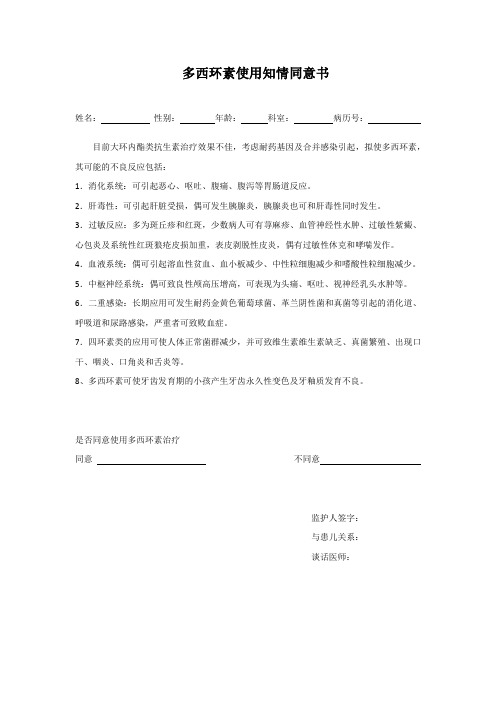
多西环素使用知情同意书姓名:性别:年龄:科室:病历号:目前大环内酯类抗生素治疗效果不佳,考虑耐药基因及合并感染引起,拟使多西环素,其可能的不良反应包括:1.消化系统:可引起恶心、呕吐、腹痛、腹泻等胃肠道反应。
2.肝毒性:可引起肝脏受损,偶可发生胰腺炎,胰腺炎也可和肝毒性同时发生。
3.过敏反应:多为斑丘疹和红斑,少数病人可有荨麻疹、血管神经性水肿、过敏性紫癜、心包炎及系统性红斑狼疮皮损加重,表皮剥脱性皮炎,偶有过敏性休克和哮喘发作。
4.血液系统:偶可引起溶血性贫血、血小板减少、中性粒细胞减少和嗜酸性粒细胞减少。
5.中枢神经系统:偶可致良性颅高压增高,可表现为头痛、呕吐、视神经乳头水肿等。
6.二重感染:长期应用可发生耐药金黄色葡萄球菌、革兰阴性菌和真菌等引起的消化道、呼吸道和尿路感染,严重者可致败血症。
7.四环素类的应用可使人体正常菌群减少,并可致维生素维生素缺乏、真菌繁殖、出现口干、咽炎、口角炎和舌炎等。
8、多西环素可使牙齿发育期的小孩产生牙齿永久性变色及牙釉质发育不良。
是否同意使用多西环素治疗同意不同意监护人签字:与患儿关系:谈话医师:左氧氟沙星知情同意书床号:姓名住院号目前考虑诊断为:目前大环内酯类抗生素治疗效果不佳,考虑耐药基因及合并感染引起,改为左氧氟沙星治疗,以下为左氧氟沙星副作用:严重和其他重要的不良反应,致残和潜在的不可逆转的严重不良反应,包括肌腱炎和肌腱断裂,周围神经病变,中枢神经系统的影响:肝肾功能损害;肌腱病和肌腱断裂;重症肌无力恶化;QT 间期延长;过敏反应/超敏反应,皮疹;其他严重并且有时致命的反应;中枢神经系统的影响;艰难梭菌相关性腹泻;周围神经病变;对血糖的干扰;光敏感性/光毒性;儿科患者中的肌肉骨骼疾病和耐药细菌产生;主动脉瘤和主动脉夹层的风险。
谈话医生:地点:监护人签字:与患儿关系:。
多迪(盐酸多西环素分散片)
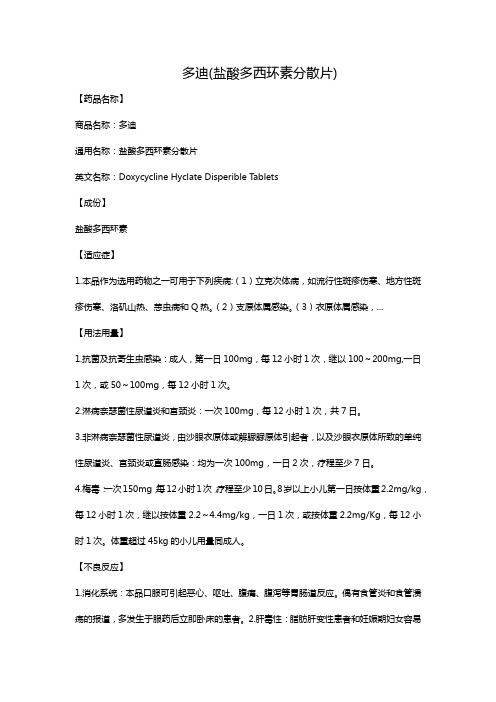
多迪(盐酸多西环素分散片)【药品名称】商品名称:多迪通用名称:盐酸多西环素分散片英文名称:Doxycycline Hyclate Disperible T ablets【成份】盐酸多西环素【适应症】1.本品作为选用药物之一可用于下列疾病:(1)立克次体病,如流行性斑疹伤寒、地方性斑疹伤寒、洛矶山热、恙虫病和Q热。
(2)支原体属感染。
(3)衣原体属感染,...【用法用量】1.抗菌及抗寄生虫感染:成人,第一日100mg,每12小时1次,继以100~200mg,一日1次,或50~100mg,每12小时1次。
2.淋病奈瑟菌性尿道炎和宫颈炎:一次100mg,每12小时1次,共7日。
3.非淋病奈瑟菌性尿道炎,由沙眼衣原体或解脲脲原体引起者,以及沙眼衣原体所致的单纯性尿道炎、宫颈炎或直肠感染:均为一次100mg,一日2次,疗程至少7日。
4.梅毒:一次150mg,每12小时1次,疗程至少10日。
8岁以上小儿第一日按体重2.2mg/kg,每12小时1次,继以按体重2.2~4.4mg/kg,一日1次,或按体重2.2mg/Kg,每12小时1次。
体重超过45kg的小儿用量同成人。
【不良反应】1.消化系统:本品口服可引起恶心、呕吐、腹痛、腹泻等胃肠道反应。
偶有食管炎和食管溃疡的报道,多发生于服药后立即卧床的患者。
2.肝毒性:脂肪肝变性患者和妊娠期妇女容易发生,亦可发生于并无上述情况的患者。
偶可发生胰腺炎,本品所致胰腺炎也可与肝毒性同时发生,患者并不伴有原发肝病。
3.过敏反应:多为斑丘疹和红斑,少数病人可有荨麻疹、血管神经性水肿、过敏性紫癜、心包炎以及系统性红斑狼疮皮损加重,表皮剥脱性皮炎并不常见。
偶有过敏性休克和哮喘发生。
某些用本品的患者日晒可有光敏现象。
所以,建议患者服用本品期间不要直接【禁忌】有四环素类药物过敏史者禁用。
【注意事项】1.应用本品时可能发生耐药菌的过度繁殖。
一旦发生二重感染,即停用本品并予以相应治疗。
2.治疗性病时,如怀疑同时合并梅毒螺旋体感染,用药前须行暗视野显微镜检查及血清学检查,后者每月1次,至少4次。
盐酸多西环素可溶性粉
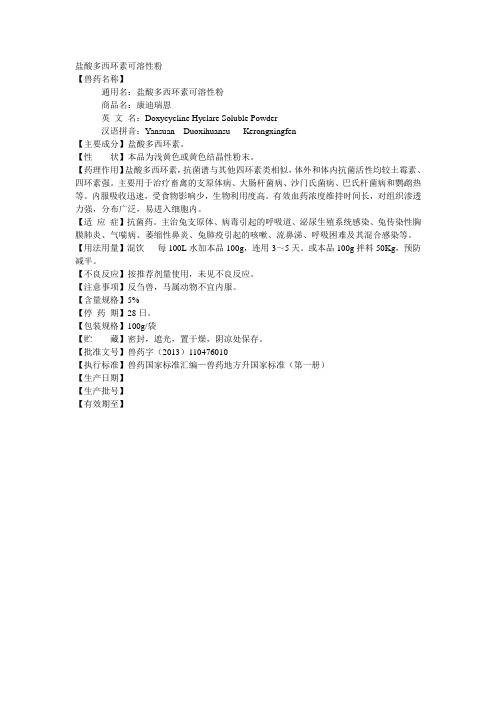
盐酸多西环素可溶性粉
【兽药名称】
通用名:盐酸多西环素可溶性粉
商品名:康迪瑞恩
英文名:Doxycycline Hyclare Soluble Powder
汉语拼音:Yansuan Duoxihuansu Kerongxingfen
【主要成分】盐酸多西环素。
【性状】本品为浅黄色或黄色结晶性粉末。
【药理作用】盐酸多西环素,抗菌谱与其他四环素类相似,体外和体内抗菌活性均较土霉素、四环素强。
主要用于治疗畜禽的支原体病、大肠杆菌病、沙门氏菌病、巴氏杆菌病和鹦鹉热等。
内服吸收迅速,受食物影响少,生物利用度高。
有效血药浓度维持时间长,对组织渗透力强,分布广泛,易进入细胞内。
【适应症】抗菌药。
主治兔支原体、病毒引起的呼吸道、泌尿生殖系统感染、兔传染性胸膜肺炎、气喘病、萎缩性鼻炎、兔肺疫引起的咳嗽、流鼻涕、呼吸困难及其混合感染等。
【用法用量】混饮每100L水加本品100g,连用3~5天。
或本品100g拌料50Kg,预防减半。
【不良反应】按推荐剂量使用,未见不良反应。
【注意事项】反刍兽,马属动物不宜内服。
【含量规格】5%
【停药期】28日。
【包装规格】100g/袋
【贮藏】密封,遮光,置干燥,阴凉处保存。
【批准文号】兽药字(2013)110476010
【执行标准】兽药国家标准汇编—兽药地方升国家标准(第一册)
【生产日期】
【生产批号】
【有效期至】。
兽用国标多西环素说明书

兽用国标多西环素说明书一、药品名称:兽用国标多西环素二、药品成分:每片含多西环素XX毫克(以多西环素盐酸盐计)三、药物性状:本品为片剂,外观为圆形,表面光滑,颜色为白色或略带黄色。
四、适应症:兽用国标多西环素适用于家禽、家畜以及其他养殖动物的疾病治疗,包括但不限于下列病症:1. 呼吸道感染:主要用于禽流感、鸡传染性鼻炎、猪繁殖与呼吸综合征等呼吸道感染引起的临床症状;2. 非呼吸道感染:适用于母猪产后感染子宫、喉炎、肠炎、尿路感染等疾病;3. 皮肤和软组织感染:可用于治疗褥疮、皮肤溃烂、败血症等细菌感染引起的病症;4. 泌尿生殖系统感染:适用于治疗家禽和家畜的尿道炎、睾丸炎以及其他泌尿生殖系统细菌感染等。
五、用法和用量:1. 按体重给药:每千克体重使用多西环素的剂量为X-X毫克,具体用量根据动物的病情和体重进行调整,建议咨询兽医师。
2. 给药途径:口服给药。
将药片直接投喂给动物,或将药物研磨并与饲料混合喂食。
3. 用药间隔:根据兽医师的指示,按照规定的次数和间隔进行用药。
六、不良反应:1. 在正常剂量下使用,本药品一般不会引起明显的不良反应。
但个别动物可能出现注意力不集中、食欲减退、腹泻等消化道不适症状,如有上述情况,请立即停药并咨询兽医师。
2. 长期大剂量使用可能会引起肝脏和肾脏功能损伤等不良反应,应遵医嘱进行观察和检测。
七、禁忌:1. 对多西环素或本品中其他成分过敏者禁用。
2. 孕期、哺乳期的母动物慎用,应咨询兽医师的意见。
八、注意事项:1. 请咨询兽医师或其他合格医疗保健专业人员的建议,确保正确使用药品,并仔细阅读说明书。
2. 该药品仅用于动物治疗,禁止人用,存放在儿童无法接触的地方。
3. 药品过期或瓶盖已损坏时禁止使用。
4. 使用本品过程中如有不适或疑问,请及时咨询兽医师或其他合格医疗保健专业人员。
九、包装规格:每瓶装X片,每片含多西环素XX毫克。
十、执行标准:符合国家药品监督管理局颁布的相关药品质量标准。
戴立新药品说明书
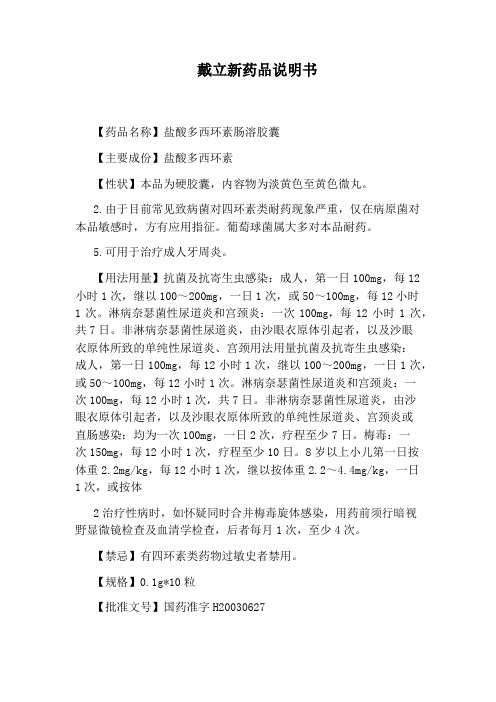
戴立新药品说明书【药品名称】盐酸多西环素肠溶胶囊【主要成份】盐酸多西环素【性状】本品为硬胶囊,内容物为淡黄色至黄色微丸。
2.由于目前常见致病菌对四环素类耐药现象严重,仅在病原菌对本品敏感时,方有应用指征。
葡萄球菌属大多对本品耐药。
5.可用于治疗成人牙周炎。
【用法用量】抗菌及抗寄生虫感染:成人,第一日100mg,每12小时1次,继以100~200mg,一日1次,或50~100mg,每12小时1次。
淋病奈瑟菌性尿道炎和宫颈炎:一次100mg,每12小时1次,共7日。
非淋病奈瑟菌性尿道炎,由沙眼衣原体引起者,以及沙眼衣原体所致的单纯性尿道炎、宫颈用法用量抗菌及抗寄生虫感染:成人,第一日100mg,每12小时1次,继以100~200mg,一日1次,或50~100mg,每12小时1次。
淋病奈瑟菌性尿道炎和宫颈炎:一次100mg,每12小时1次,共7日。
非淋病奈瑟菌性尿道炎,由沙眼衣原体引起者,以及沙眼衣原体所致的单纯性尿道炎、宫颈炎或直肠感染:均为一次100mg,一日2次,疗程至少7日。
梅毒:一次150mg,每12小时1次,疗程至少10日。
8岁以上小儿第一日按体重2.2mg/kg,每12小时1次,继以按体重2.2~4.4mg/kg,一日1次,或按体2治疗性病时,如怀疑同时合并梅毒旋体感染,用药前须行暗视野显微镜检查及血清学检查,后者每月1次,至少4次。
【禁忌】有四环素类药物过敏史者禁用。
【规格】0.1g*10粒【批准文号】国药准字H20030627盐酸多西环素肠溶胶囊是四环素类抗生素,本品为广谱抑菌剂,高浓度时具有杀菌作用,其用法用量及疗程如下:1、抗菌及抗寄生虫感染:成人,第一日100mg(0.1g/粒),每12小时1次,继以100~200mg,一日1次,或50~100mg,每12小时1次。
2、淋病奈瑟菌性尿道炎和宫颈炎:一次100mg,每12小时1次,共7日。
3、非淋病奈瑟菌性尿道炎,由沙眼衣原体引起者,以及沙眼衣原体所致的单纯性尿道炎、宫颈炎或直肠感染:均为一次100mg,一日2次,疗程至少7日。
多西环素说明书
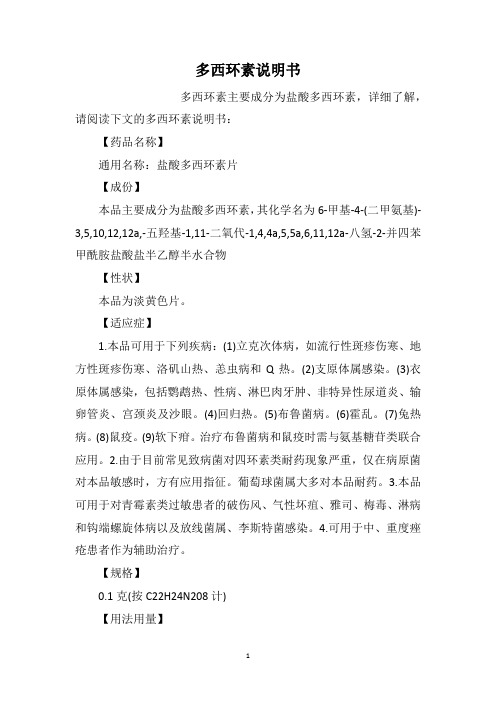
多西环素说明书多西环素主要成分为盐酸多西环素,详细了解,请阅读下文的多西环素说明书:【药品名称】通用名称:盐酸多西环素片【成份】本品主要成分为盐酸多西环素,其化学名为6-甲基-4-(二甲氨基)-3,5,10,12,12a,-五羟基-1,11-二氧代-1,4,4a,5,5a,6,11,12a-八氢-2-并四苯甲酰胺盐酸盐半乙醇半水合物【性状】本品为淡黄色片。
【适应症】1.本品可用于下列疾病:(1)立克次体病,如流行性斑疹伤寒、地方性斑疹伤寒、洛矶山热、恙虫病和Q热。
(2)支原体属感染。
(3)衣原体属感染,包括鹦鹉热、性病、淋巴肉牙肿、非特异性尿道炎、输卵管炎、宫颈炎及沙眼。
(4)回归热。
(5)布鲁菌病。
(6)霍乱。
(7)兔热病。
(8)鼠疫。
(9)软下疳。
治疗布鲁菌病和鼠疫时需与氨基糖苷类联合应用。
2.由于目前常见致病菌对四环素类耐药现象严重,仅在病原菌对本品敏感时,方有应用指征。
葡萄球菌属大多对本品耐药。
3.本品可用于对青霉素类过敏患者的破伤风、气性坏疽、雅司、梅毒、淋病和钩端螺旋体病以及放线菌属、李斯特菌感染。
4.可用于中、重度痤疮患者作为辅助治疗。
【规格】0.1克(按C22H24N208计)【用法用量】药物不能随便增减量,具体服用量应参照说明书或遵医嘱。
具体就盐酸多西环素片来说,对不同的病症服用量也是不同的。
抗菌及抗寄生虫感染:成人,第一日100mg,每12小时1次,继以100~200mg,一日1次,或50~100mg,每12小时1次。
淋病奈瑟菌性尿道炎和宫颈炎:一次100mg,每12小时1次。
共7日。
非淋病奈瑟菌性尿道炎,由沙眼衣原体或解脲脲原体引起者,以及沙眼衣原体所致的单纯性尿道炎、宫颈炎或直肠感染:均为一次100mg,一日2次,疗程至少7日。
梅毒:一次150mg,每12小时1次,疗程至少10日。
8岁以上小儿第一日按体重2.2mg/kg,每12小时1次,继以按体重2.2~4.4mg/kg,一日1次,或按体重2.2mg/kg,每12小时1次。
盐酸多西环素片
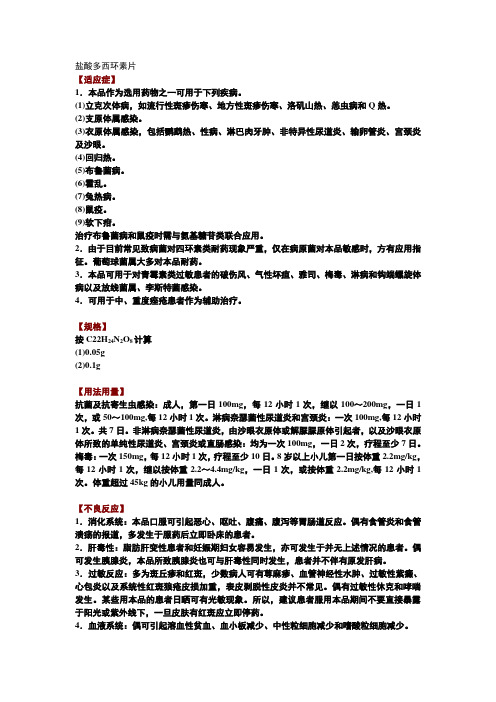
盐酸多西环素片【适应症】1.本品作为选用药物之一可用于下列疾病。
(1)立克次体病,如流行性斑疹伤寒、地方性斑疹伤寒、洛矶山热、恙虫病和Q热。
(2)支原体属感染。
(3)衣原体属感染,包括鹦鹉热、性病、淋巴肉牙肿、非特异性尿道炎、输卵管炎、宫颈炎及沙眼。
(4)回归热。
(5)布鲁菌病。
(6)霍乱。
(7)兔热病。
(8)鼠疫。
(9)软下疳。
治疗布鲁菌病和鼠疫时需与氨基糖苷类联合应用。
2.由于目前常见致病菌对四环素类耐药现象严重,仅在病原菌对本品敏感时,方有应用指征。
葡萄球菌属大多对本品耐药。
3.本品可用于对青霉素类过敏患者的破伤风、气性坏疽、雅司、梅毒、淋病和钩端螺旋体病以及放线菌属、李斯特菌感染。
4.可用于中、重度痤疮患者作为辅助治疗。
【规格】按C22H24N2O8计算(1)0.05g(2)0.1g【用法用量】抗菌及抗寄生虫感染:成人,第一日100mg,每12小时1次,继以100~200mg,一日1次,或50~100mg,每12小时1次。
淋病奈瑟菌性尿道炎和宫颈炎:一次100mg,每12小时1次。
共7日。
非淋病奈瑟菌性尿道炎,由沙眼衣原体或解脲脲原体引起者,以及沙眼衣原体所致的单纯性尿道炎、宫颈炎或直肠感染:均为一次100mg,一日2次,疗程至少7日。
梅毒:一次150mg,每12小时1次,疗程至少10日。
8岁以上小儿第一日按体重2.2mg/kg,每12小时1次,继以按体重2.2~4.4mg/kg,一日1次,或按体重2.2mg/kg,每12小时1次。
体重超过45kg的小儿用量同成人。
【不良反应】1.消化系统:本品口服可引起恶心、呕吐、腹痛、腹泻等胃肠道反应。
偶有食管炎和食管溃疡的报道,多发生于服药后立即卧床的患者。
2.肝毒性:脂肪肝变性患者和妊娠期妇女容易发生,亦可发生于并无上述情况的患者。
偶可发生胰腺炎,本品所致胰腺炎也可与肝毒性同时发生,患者并不伴有原发肝病。
3.过敏反应:多为斑丘疹和红斑,少数病人可有荨麻疹、血管神经性水肿、过敏性紫癜、心包炎以及系统性红斑狼疮皮损加重,表皮剥脱性皮炎并不常见。
多西环素

3.多西环素也可用于治疗敏感菌所致的呼吸道、胆道、尿路和皮肤软组织感染。
4.由于无明显肾脏毒性,多西环素也可用于有四环素适应证但合并肾功能损害的感染患者。
5.多西环素还可短期服用作为旅行者腹泻的预防用药。
化合物简介
物化性质
基本信息
用途
中文名称:多西环素 中文别名:强力霉素;6-甲基-4-(二甲氨基)-3,5,10,12,12a-五羟基-1,11-二氧代1,4,4a,5,5a,6,11,12a-八氢-2-并四苯甲酰胺;脱氧土霉素; 英文名称:doxycycline CAS号:564-25-0 分子式:C22H24N2O8 结构式: 分子量:444.435 精确质量:444. PSA:181. LogP:0.
用于敏感的革兰阳性菌和革兰阴性杆菌所致的上呼吸道感染、扁桃体炎、胆道感染、淋巴结炎、蜂窝组炎、 老年慢性支气管炎等,也用于治疗斑疹伤寒、羌虫病、支原体肺炎等。尚可用于治疗霍乱,也可用于预防恶性疟 疾和钩端螺旋体感染。主要用于敏感的革兰阳性球菌和革兰阴性杆菌所致的上呼吸道感染、扁桃体炎、胆道感染、 淋巴结炎、蜂窝组织炎、老年慢性支气管炎等,也用于斑疹伤寒、恙虫病、支原体肺炎等。尚可用于治疗霍乱, 也可用于预防恶性疟疾和勾端螺旋体感染。
注意事项
儿童用药
孕妇及哺乳期妇女 用药
老年用药
孕妇静脉注射多西环素的研究还未进行。在无医嘱的情况下,不得给孕妇使用。 动物实验表明,四环素类药物能通过胎盘,在胎儿组织中发现药物,对胎儿的发育有毒性(妨碍骨骼的生 长)。在动物怀孕初期用药产生的胚胎毒性已有记载。 哺乳期妇女服用该类药物后乳汁中发现药物存在。
戴立新药品说明书
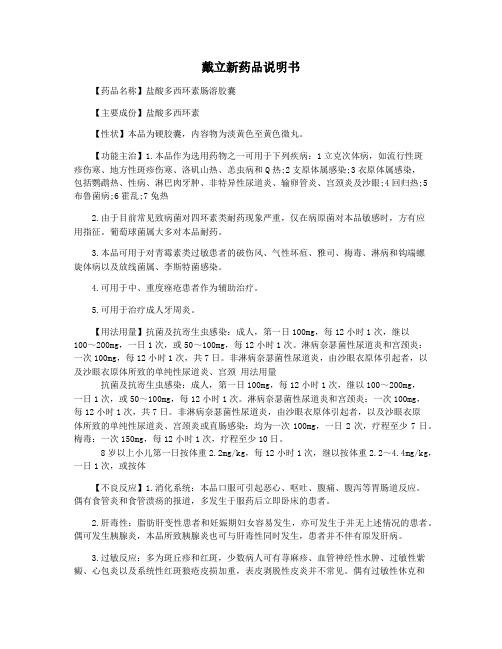
戴立新药品说明书【药品名称】盐酸多西环素肠溶胶囊【主要成份】盐酸多西环素【性状】本品为硬胶囊,内容物为淡黄色至黄色微丸。
【功能主治】1.本品作为选用药物之一可用于下列疾病:1立克次体病,如流行性斑疹伤寒、地方性斑疹伤寒、洛矶山热、恙虫病和Q热;2支原体属感染;3衣原体属感染,包括鹦鹉热、性病、淋巴肉牙肿、非特异性尿道炎、输卵管炎、宫颈炎及沙眼;4回归热;5布鲁菌病;6霍乱;7兔热2.由于目前常见致病菌对四环素类耐药现象严重,仅在病原菌对本品敏感时,方有应用指征。
葡萄球菌属大多对本品耐药。
3.本品可用于对青霉素类过敏患者的破伤风、气性坏疽、雅司、梅毒、淋病和钩端螺旋体病以及放线菌属、李斯特菌感染。
4.可用于中、重度痤疮患者作为辅助治疗。
5.可用于治疗成人牙周炎。
【用法用量】抗菌及抗寄生虫感染:成人,第一日100mg,每12小时1次,继以100~200mg,一日1次,或50~100mg,每12小时1次。
淋病奈瑟菌性尿道炎和宫颈炎:一次100mg,每12小时1次,共7日。
非淋病奈瑟菌性尿道炎,由沙眼衣原体引起者,以及沙眼衣原体所致的单纯性尿道炎、宫颈用法用量抗菌及抗寄生虫感染:成人,第一日100mg,每12小时1次,继以100~200mg,一日1次,或50~100mg,每12小时1次。
淋病奈瑟菌性尿道炎和宫颈炎:一次100mg,每12小时1次,共7日。
非淋病奈瑟菌性尿道炎,由沙眼衣原体引起者,以及沙眼衣原体所致的单纯性尿道炎、宫颈炎或直肠感染:均为一次100mg,一日2次,疗程至少7日。
梅毒:一次150mg,每12小时1次,疗程至少10日。
8岁以上小儿第一日按体重2.2mg/kg,每12小时1次,继以按体重2.2~4.4mg/kg,一日1次,或按体【不良反应】1.消化系统:本品口服可引起恶心、呕吐、腹痛、腹泻等胃肠道反应。
偶有食管炎和食管溃疡的报道,多发生于服药后立即卧床的患者。
2.肝毒性:脂肪肝变性患者和妊娠期妇女容易发生,亦可发生于并无上述情况的患者。
强力霉素说明书
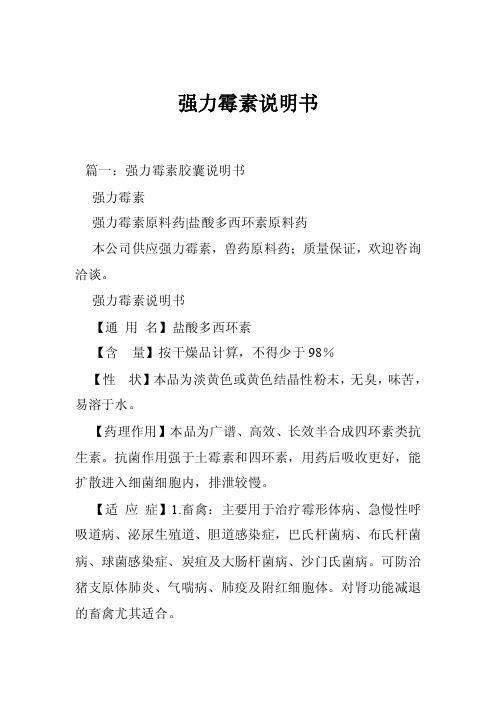
强力霉素说明书篇一:强力霉素胶囊说明书强力霉素强力霉素原料药|盐酸多西环素原料药本公司供应强力霉素,兽药原料药;质量保证,欢迎咨询洽谈。
强力霉素说明书【通用名】盐酸多西环素【含量】按干燥品计算,不得少于98%【性状】本品为淡黄色或黄色结晶性粉末,无臭,味苦,易溶于水。
【药理作用】本品为广谱、高效、长效半合成四环素类抗生素。
抗菌作用强于土霉素和四环素,用药后吸收更好,能扩散进入细菌细胞内,排泄较慢。
【适应症】1.畜禽:主要用于治疗霉形体病、急慢性呼吸道病、泌尿生殖道、胆道感染症,巴氏杆菌病、布氏杆菌病、球菌感染症、炭疽及大肠杆菌病、沙门氏菌病。
可防治猪支原体肺炎、气喘病、肺疫及附红细胞体。
对肾功能减退的畜禽尤其适合。
2.水产:可用于防治鱼类细菌性败血症、白皮病、赤皮病、白头白嘴病、打印病、肠炎病、烂鳃病、坚鳞病等水产动物疾病。
如:牙鲆、菱鲆的链球菌病;鲈形目的弧菌病和链球菌病;鲱形目的疖疮病和弧菌病;蝶形目的链球菌病;对虾红腿病、瞎眼病、褐斑病;珍珠蚌水肿病、蛙细菌性疾病;鳖穿孔病、红脖子病等。
【用法用量】1.拌料:禽类:本品每克拌料7公斤~9公斤,连用3~5天;重症加倍。
畜类:本品每克拌料9公斤~11公斤,连3~5天;重症加倍。
饮水:禽类:本品每克兑水10公斤~12公斤,连用3~5天;重症加倍。
畜类:本品每克兑水12~14公斤,连用3~5天;重症加倍。
2.水产:每千克饵料加入本品0.3~0.7克,连用5~7天。
全池泼洒0.7~1.5ppm,药浴4~6ppm/小时;重症加倍。
(视苗体大小调整)【包装规格】500g/袋×2袋/桶或25kg/桶【不良反应】正确使用未见不良反应【休药期】无【贮藏】阴凉、干燥处、密封保存欢迎广大客户来电订购;厂家直销&篇二:小版本1083-01强力霉素(二步法)说明书美国柏尔生物技术公司(BIOO Scientific Co.)RMaxSignal○强力霉素酶联免疫反应测试盒使用说明书(M1083-01) 一. 简介1.试剂盒描述R强力霉素酶联免疫反应测试盒利用竞争性酶联免疫反应原理,对蜂MaxSignal○蜜、牛奶、尿液、肉类等中强力霉素残留进行定量检测。
盐酸多西环素缓释片FDA说明书
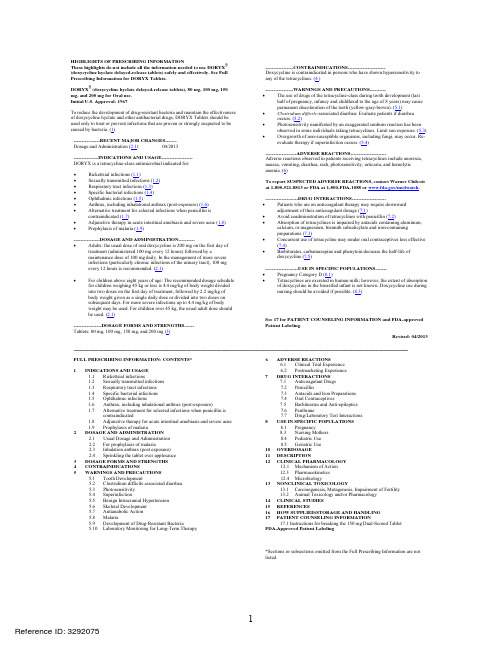
____________________________________________________________________HIGHLIGHTS OF PRESCRIBING INFORMATIONThese highlights do not include all the information needed to use DORYX ®(doxycycline hyclate delayed-release tablets) safely and effectively. See Full Prescribing Information for DORYX Tablets. DORYX ® (doxycycline hyclate delayed-release tablets), 80 mg, 100 mg, 150 mg, and 200 mg for Oral use. Initial U.S. Approval: 1967 To reduce the development of drug-resistant bacteria and maintain the effectiveness of doxycycline hyclate and other antibacterial drugs, DORYX Tablets should be used only to treat or prevent infections that are proven or strongly suspected to be caused by bacteria. (1) ----------------RECENT MAJOR CHANGES------- Dosage and Administration (2.1) 04/2013 ---------------INDICATIONS AND USAGE------------------DORYX is a tetracycline-class antimicrobial indicated for:• Rickettsial infections (1.1) • Sexually transmitted infections (1.2) • Respiratory tract infections (1.3) • Specific bacterial infections (1.4) • Ophthalmic infections (1.5) • Anthrax, including inhalational anthrax (post-exposure) (1.6) • Alternative treatment for selected infections when penicillin is contraindicated (1.7) • Adjunctive therapy in acute intestinal amebiasis and severe acne (1.8) • Prophylaxis of malaria (1.9) ----------------DOSAGE AND ADMINISTRATION---------- • Adults: the usual dose of oral doxycycline is 200 mg on the first day oftreatment (administered 100 mg every 12 hours) followed by amaintenance dose of 100 mg daily. In the management of more severe infections (particularly chronic infections of the urinary tract), 100 mg every 12 hours is recommended. (2.1) • For children above eight years of age: The recommended dosage schedule for children weighing 45 kg or less is 4.4 mg/kg of body weight divided into two doses on the first day of treatment, followed by 2.2 mg/kg of body weight given as a single daily dose or divided into two doses on subsequent days. For more severe infections up to 4.4 mg/kg of body weight may be used. For children over 45 kg, the usual adult dose should be used. (2.1) -----------------DOSAGE FORMS AND STRENGTHS------ Tablets: 80 mg, 100 mg, 150 mg, and 200 mg (3) -----------------CONTRAINDICATIONS-----------------------Doxycycline is contraindicated in persons who have shown hypersensitivity to any of the tetracyclines. (4 ) -----------------WARNINGS AND PRECAUTIONS---------- • The use of drugs of the tetracycline-class during tooth development (last half of pregnancy, infancy and childhood to the age of 8 years) may cause permanent discoloration of the teeth (yellow-gray-brown). (5.1)• Clostridium difficile -associated diarrhea: Evaluate patients if diarrhea occurs. (5.2) • Photosensitivity manifested by an exaggerated sunburn reaction has been observed in some individuals taking tetracyclines. Limit sun exposure. (5.3) • Overgrowth of non-susceptible organisms, including fungi, may occur. Reevaluate therapy if superinfection occurs. (5.4) -------------------ADVERSE REACTIONS---------------------Adverse reactions observed in patients receiving tetracyclines include anorexia, nausea, vomiting, diarrhea, rash, photosensitivity, urticaria, and hemolytic anemia. (6) To report SUSPECTED ADVERSE REACTIONS, contact Warner Chilcott at 1-800-521-8813 or FDA at 1-800-FDA-1088 or /medwatch . --------------------DRUG INTERACTIONS--------------------• Patients who are on anticoagulant therapy may require downward adjustment of their anticoagulant dosage (7.1) • Avoid coadministration of tetracyclines with penicillin (7.2) • Absorption of tetracyclines is impaired by antacids containing aluminum, calcium, or magnesium, bismuth subsalicylate and iron-containing preparations (7.3) • Concurrent use of tetracycline may render oral contraceptives less effective (7.4) • Barbiturates, carbamazepine and phenytoin decrease the half-life of doxycycline (7.5) --------------------USE IN SPECIFIC POPULATIONS------• Pregnancy Category D (8.1) • Tetracyclines are excreted in human milk; however, the extent of absorption of doxycycline in the breastfed infant is not known. Doxycycline use during nursing should be avoided if possible. (8.3) See 17 for PATIENT COUNSELING INFORMATION and FDA-approved Patient Labeling . Revised: 04/2013 FULL PRESCRIBING INFORMATION: CONTENTS* 1 INDICATIONS AND USAGE 1.1 R ickettsial infections 1.2 Sexually transmitted infections 1.3 Respiratory tract infections 1.4 Specific bacterial infections 1.5 Ophthalmic infections1.6 Anthrax, including inhalational anthrax (post-exposure) 1.7 Alternative treatment for selected infections when penicillin iscontraindicated1.8 Adjunctive therapy for acute intestinal amebiasis and severe acne 1.9 Prophylaxis of malaria 2 DOSAGE AND ADMINISTRATION2.1 Usual Dosage and Administration 2.2 For prophylaxis of malaria 2.3 Inhalation anthrax (post exposure) 2.4 Sprinkling the tablet over applesauce3 DOSAGE FORMS AND STRENGTHS4 CONTRAINDICATIONS5 WARNINGS AND PRECAUTIONS5.1 T ooth Development 5.2 Clostridium difficile associated diarrhea 5.3 Photosensitivity 5.4 Superinfection 5.5 Benign Intracranial Hypertension 5.6 Skeletal Development 5.7 Antianabolic Action 5.8 Malaria 5.9 Development of Drug-Resistant Bacteria 5.10 Laboratory Monitoring for Long-Term Therapy 6 ADVERSE REACTIONS6.1 Clinical Trial Experience 6.2 Postmarketing Experience 7 DRUG INTERACTIONS7.1 A nticoagulant Drugs 7.2 Penicillin 7.3 Antacids and Iron Preparations 7.4 Oral Contraceptives 7.5 Barbiturates and Anti-epileptics 7.6 Penthrane 7.7 Drug/Laboratory Test Interactions 8 USE IN SPECIFIC POPULATIONS8.1 P regnancy 8.3 Nursing Mothers 8.4 Pediatric Use 8.5 Geriatric Use 10 OVERDOSAGE 11 DESCRIPTION 12 CLINICAL PHARMACOLOGY 12.1 Mechanism of Action 12.3 Pharmacokinetics 12.4 Microbiology 13 NONCLINICAL TOXICOLOGY 13.1 Carcinogenesis, Mutagenesis, Impairment of Fertility 13.2 Animal Toxicology and/or Pharmacology 14 CLINICAL STUDIES 15 REFERENCES16 HOW SUPPLIED/STORAGE AND HANDLING 17 PATIENT COUNSELING INFORMATION 17.1 Instructions for breaking the 150 mg Dual-Scored Tablet FDA-Approved Patient Labeling*Sections or subsections omitted from the Full Prescribing Information are not listed.1 INDICATIONS AND USAGETo reduce the development of drug-resistant bacteria and maintain the effectiveness of DORYX and other antibacterial drugs, DORYX should be used only to treat or prevent infections that are proven or strongly suspected to be caused by susceptible bacteria. When culture and susceptibility information are available, they should be considered in selecting or modifying antibacterial therapy. In the absence of such data, local epidemiology and susceptibility patterns may contribute to the empiric selection of therapy.Doxycycline is a tetracycline-class antimicrobial indicated in the following conditions or diseases:1.1 RickettsialinfectionsRocky Mountain spotted fever, typhus fever and the typhus group, Q fever, rickettsialpox, and tick fevers caused by Rickettsiae.1.2 Sexually transmitted infectionsUncomplicated urethral, endocervical or rectal infections caused by Chlamydia trachomatis.Nongonococcal urethritis caused by Ureaplasma urealyticum.Lymphogranuloma venereum caused by Chlamydia trachomatis.Granuloma inguinale caused by Calymmatobacterium granulomatis. Uncomplicated gonorrhea caused by Neisseria gonorrhoeae.Chancroid caused by Haemophilus ducreyi.infections1.3 RespiratorytractRespiratory tract infections caused by Mycoplasma pneumoniae.Psittacosis (ornithosis) caused by Chlamydophila psittaci.Because many strains of the following groups of microorganisms have been shown to be resistant to doxycycline, culture and susceptibility testing are recommended. Doxycycline is indicated for treatment of infections caused by the following microorganisms, when bacteriological testing indicates appropriate susceptibility to the drug: Respiratory tract infections caused by Haemophilus influenzae.Respiratory tract infections caused by Klebsiella species.Upper respiratory infections caused by Streptococcus pneumoniae.1.4 Specific bacterial infectionsRelapsing fever due to Borrelia recurrentis.Plague due to Yersinia pestis.Tularemia due to Francisella tularensis.Cholera caused by Vibrio cholerae.Campylobacter fetus infections caused by Campylobacter fetus.Brucellosis due to Brucella species (in conjunction with streptomycin). Bartonellosis due to Bartonella bacilliformis.Because many strains of the following groups of microorganisms have been shown to be resistant to doxycycline, culture and susceptibility testing are recommended. Doxycycline is indicated for treatment of infections caused by the following gram-negative microorganisms, when bacteriological testing indicates appropriate susceptibility to the drug:Escherichia coliEnterobacter aerogenesShigella speciesAcinetobacter speciesUrinary tract infections caused by Klebsiella species.infections1.5 O phthalmicTrachoma caused by Chlamydia trachomatis, although the infectious agent is not always eliminated as judged by immunofluorescence.Inclusion conjunctivitis caused by Chlamydia trachomatis.1.6 Anthrax including inhalational anthrax (post-exposure)Anthrax due to Bacillus anthracis, including inhalational anthrax (post-exposure): to reduce the incidence or progression of disease following exposure to aerosolized Bacillus anthracis.1.7 Alternative treatment for selected infections when penicillin iscontraindicatedWhen penicillin is contraindicated, doxycycline is an alternative drug in the treatment of the following infections:Syphilis caused by Treponema pallidum.Yaws caused by Treponema pertenue.Vincent’s infection caused by Fusobacterium fusiforme.Actinomycosis caused by Actinomyces israelii.Infections caused by Clostridium species.1.8 Adjunctive therapy for acute intestinal amebiasis and severe acneIn acute intestinal amebiasis, doxycycline may be a useful adjunct to amebicides.In severe acne, doxycycline may be useful adjunctive therapy.1.9 Prophylaxis of malariaDoxycycline is indicated for the prophylaxis of malaria due to Plasmodium falciparum in short-term travelers (less than 4 months) to areas with chloroquine and/or pyrimethamine-sulfadoxine resistant strains [see Dosage and Administration (2.2) and Patient Counseling Information (17)].2 DOSAGE AND ADMINISTRATION2.1 Usual Dosage and AdministrationTHE USUAL DOSAGE AND FREQUENCY OF ADMINISTRATION OF DOXYCYCLINE DIFFERS FROM THAT OF THE OTHER TETRACYCLINES. EXCEEDING THE RECOMMENDED DOSAGE MAY RESULT IN AN INCREASED INCIDENCE OF SIDE EFFECTS.Adults: The usual dose of oral doxycycline is 200 mg on the first day of treatment (administered 100 mg every 12 hours), followed by a maintenance dose of 100 mg daily. The maintenance dose may be administered as a single dose or as 50 mg every 12 hours. In the management of more severe infections (particularly chronic infections of the urinary tract), 100 mg every 12 hours is recommended.For pediatric patients above eight years of age: The recommended dosage schedule for children weighing 45 kg or less is 4.4 mg/kg of body weight divided into two doses on the first day of treatment, followed by 2.2 mg/kg of body weight given as a single daily dose or divided into two doses on subsequent days. For more severe infections up to 4.4 mg/kg of body weight may be used. For children over 45 kg, the usual adult dose should be used.Administration of adequate amounts of fluid along with capsule and tablet forms of drugs in the tetracycline-class is recommended to wash down the drugs and reduce the risk of esophageal irritation and ulceration [see Adverse Reactions (6.1)].If gastric irritation occurs, doxycycline may be given with food or milk [see Clinical Pharmacology (12)].When used in streptococcal infections, therapy should be continued for 10 days.Uncomplicated urethral, endocervical, or rectal infection caused by Chlamydia trachomatis: 100 mg by mouth twice a day for 7 days. As an alternate dosing regimen for uncomplicated urethral or endocervical infection caused by Chlamydia trachomatis, administer 200 mg by mouth once-a-day for 7 days.Uncomplicated gonococcal infections in adults (except anorectal infections in men): 100 mg, by mouth, twice-a-day for 7 days. As an alternate single visit dose, administer 300 mg stat followed in one hour by a second 300 mg dose.Nongonococcal urethritis (NGU) caused by U. urealyticum: 100 mg by mouth twice-aday for 7 days.Syphilis – early: Patients who are allergic to penicillin should be treated with doxycycline 100 mg by mouth twice-a-day for 2 weeks.Syphilis of more than one year’s duration: Patients who are allergic to penicillin should be treated with doxycycline 100 mg by mouth twice-a-day for 4 weeks.Acute epididymo-orchitis caused by C. trachomatis: 100 mg, by mouth, twice-a-day for at least 10 days.2.2 For prophylaxis of malariaFor adults, the recommended dose is 100 mg daily. For children over 8 years of age, the recommended dose is 2 mg/kg given once daily up to the adult dose. Prophylaxis should begin 1 or 2 days before travel to the malarious area. Prophylaxis should be continued daily during travel in the malarious area and for 4 weeks after the traveler leaves the malarious area.2.3 Inhalational anthrax (post-exposure)ADULTS: 100 mg, of doxycycline, by mouth, twice-a-day for 60 days. CHILDREN: weighing less than 45 kg, 2.2 mg/kg of body weight, by mouth, twice-a-day for 60 days. Children weighing 45 kg or more should receive the adult dose.2.4 Sprinkling the tablet over applesauceDORYX Tablets may also be administered by carefully breaking up the tablet and sprinkling the tablet contents (delayed-release pellets) on a spoonful of applesauce. The delayed-release pellets must not be crushed or damaged when breaking up the tablet. Any loss of pellets in the transfer would prevent using the dose. The applesauce/DORYX mixture should be swallowed immediately without chewing and may be followed by a glass of water if desired. The applesauce should not be hot, and it should be soft enough to be swallowed without chewing. In the event that a prepared dose ofapplesauce/DORYX Tablet cannot be taken immediately, the mixture should be discarded and not stored for later use.3 DOSAGE FORMS AND STRENGTHSDORYX (doxycycline hyclate delayed-release tablets, USP), 80 mg are white, oval scored tablets containing yellow pellets and debossed with “D|8” on one face and plain on the other. Each tablet contains specially coated pellets of doxycycline hyclate equivalent to 80 mg of doxycycline.DORYX (doxycycline hyclate delayed-release tablets, USP), 100 mg are white, oval scored tablets containing yellow pellets and debossed with “D|1” on one face and plain on the other. Each tablet contains specially coated pellets of doxycycline hyclate equivalent to 100 mg of doxycycline.DORYX (doxycycline hyclate delayed-release tablets, USP), 150 mg are white, rectangular dual-scored tablets containing yellow pellets and debossed with “D|D|D” on one face and dual-scored on the other. Each tablet contains specially coated pellets of doxycycline hyclate equivalent to 150 mg of doxycycline.DORYX (doxycycline hyclate delayed-release tablets), 200 mg are white, oval scored tablets containing yellow pellets and debossed with “D|D” on one face and plain on the other. Each tablet contains specially coated pellets of doxycycline hyclate equivalent to 200 mg of doxycycline.4 CONTRAINDICATIONSThe drug is contraindicated in persons who have shown hypersensitivity to any of the tetracyclines.PRECAUTIONSAND5 WARNINGSDevelopment5.1 ToothThe use of drugs of the tetracycline-class during tooth development (last half of pregnancy, infancy and childhood to the age of 8 years) may cause permanent discoloration of the teeth (yellow-gray-brown). This adverse reaction is more common during long-term use of the drugs but it has been observed following repeated short-term courses. Enamel hypoplasia has also been reported. Doxycycline should not be used in this age group, except for anthrax, including inhalational anthrax (post-exposure), unless other drugs are not likely to be effective or are contraindicated.5.2 Clostridium difficile associated diarrheaClostridium difficile associated diarrhea (CDAD) has been reported with use of nearly all antibacterial agents, including DORYX Tablets, and may range in severity from mild diarrhea to fatal colitis. Treatment with antibacterial agents alters the normal flora of the colon leading to overgrowth of C. difficile.C. difficile produces toxins A and B which contribute to the development of CDAD. Hypertoxin producing strains of C. difficile cause increased morbidity and mortality, as these infections can be refractory to antimicrobial therapy and may require colectomy. CDAD must be considered in all patients who present with diarrhea following antibacterial use. Careful medical history is necessary since CDAD has been reported to occur over two months after the administration of antibacterial agents.If CDAD is suspected or confirmed, ongoing antibacterial use not directed against C. difficile may need to be discontinued. Appropriate fluid and electrolyte management, protein supplementation, antibacterial treatment of C. difficile, and surgical evaluation should be instituted as clinically indicated.5.3 PhotosensitivityPhotosensitivity manifested by an exaggerated sunburn reaction has been observed in some individuals taking tetracyclines. Patients apt to be exposed to direct sunlight or ultraviolet light should be advised that this reaction can occur with tetracycline drugs, and treatment should be discontinued at the first evidence of skin erythema.5.4 SuperinfectionAs with other antibacterial preparations, use of DORYX may result in overgrowth of non-susceptible organisms, including fungi. If superinfection occurs, the antibacterial should be discontinued and appropriate therapy instituted.5.5 Benign Intracranial HypertensionBulging fontanels in infants and benign intracranial hypertension in adults have been reported in individuals receiving tetracyclines. These conditions disappeared when the drug was discontinued.5.6 SkeletalDevelopmentAll tetracyclines form a stable calcium complex in any bone-forming tissue. A decrease in fibula growth rate has been observed in prematures given oral tetracycline in doses of 25 mg/kg every six hours. This reaction was shown to be reversible when the drug was discontinued.Results of animal studies indicate that tetracyclines cross the placenta, are found in fetal tissues, and can have toxic effects on the developing fetus (often related to retardation of skeletal development). Evidence of embryotoxicity also has been noted in animals treated early in pregnancy. If any tetracycline is used during pregnancy or if the patient becomes pregnant while taking these drugs, the patient should be apprised of the potential hazard to the fetus.5.7 Antianabolic ActionThe antianabolic action of the tetracyclines may cause an increase in BUN. Studies to date indicate that this does not occur with the use of doxycycline in patients with impaired renal function.5.8 MalariaDoxycycline offers substantial but not complete suppression of the asexual blood stages of Plasmodium strains.Doxycycline does not suppress P. falciparum’s sexual blood stage gametocytes. Subjects completing this prophylactic regimen may still transmit the infection to mosquitoes outside endemic areas.5.9 Development of Drug-Resistant BacteriaPrescribing DORYX in the absence of a proven or strongly suspected bacterial infection or a prophylactic indication is unlikely to provide benefit to the patient and increases the risk of the development of drug-resistant bacteria.5.10 Laboratory Monitoring for Long-Term TherapyIn long-term therapy, periodic laboratory evaluation of organ systems, including hematopoietic, renal, and hepatic studies should be performed.REACTIONS6 ADVERSE6.1 Clinical Trial ExperienceThe safety and efficacy of DORYX Tablets, 200 mg as a single daily dose was evaluated in a multicenter, randomized, double-blind, active-controlled study. DORYX Tablets, 200 mg was given orally once-a-day for 7 days and compared to doxycycline hyclate capsules 100 mg given orally twice daily for 7 days for the treatment of men and women with uncomplicated urogenital C. trachomatis infection.Adverse events in the Safety Population were reported by 99 (40.2%) subjects in the DORYX Tablets, 200 mg treatment group and 132 (53.2%) subjects in the doxycyclinehyclate capsules reference treatment group. Most AEs were mild in intensity. The most commonly reported adverse events in both treatment groups were nausea, vomiting, diarrhea, and bacterial vaginitis, Table 1.Table 1: Adverse Reactions Reported in Greater than or Equal to 2% of SubjectsDORYX Tablets, 200 mgN = 246Preferred Term n (%)Subjects with any AE 99 (40.2)Nausea 33 (13.4)Vomiting 20 (8.1)Headache 5 (2.0)Diarrhea 8 (3.3)Abdominal Pain Upper 5 (2.0)Vaginitis Bacterial 8 (3.3)Vulvovaginal Mycotic Infection 5 (2.0)Because clinical trials are conducted under prescribed conditions, adverse reaction rates observed in the clinical trial may not always reflect the rates observed in practice.Experience6.2 PostmarketingDue to oral doxycycline’s virtually complete absorption, side effects to the lower bowel, particularly diarrhea, have been infrequent. The following adverse reactions have been observed in patients receiving tetracyclines:Gastrointestinal: Anorexia, nausea, vomiting, diarrhea, glossitis, dysphagia, enterocolitis, and inflammatory lesions (with monilial overgrowth) in the anogenital region. Hepatotoxicity has been reported. These reactions have been caused by both the oral and parenteral administration of tetracyclines. Esophagitis and esophageal ulcerations have been reported in patients receiving capsule and tablet forms of drugs in the tetracycline-class. Most of these patients took medications immediately before going to bed [see Dosage and Administration (2.1)].Skin: Maculopapular and erythematous rashes, Stevens-Johnson syndrome, toxic epidermal necrolysis, exfoliative dermatitis, and erythema multiforme have been reported. Photosensitivity is discussed above [see Warnings and Precautions (5.3)].Renal: Rise in BUN has been reported and is apparently dose-related [see Warnings and Precautions (5.7)].Hypersensitivity reactions: Urticaria, angioneurotic edema, anaphylaxis, anaphylactoid purpura, serum sickness, pericarditis, and exacerbation of systemic lupus erythematosus.Blood: Hemolytic anemia, thrombocytopenia, neutropenia, and eosinophilia have been reported.Benign Intracranial HypertensionBulging fontanels in infants and benign intracranial hypertension in adults [see Warnings and Precautions (5.5)].Thyroid Gland Changes: When given over prolonged periods, tetracyclines have been reported to produce brown-black microscopic discoloration of thyroid glands. No abnormalities of thyroid function are known to occur.INTERACTIONS7 DRUGDrugs7.1 AnticoagulantBecause tetracyclines have been shown to depress plasma prothrombin activity, patients who are on anticoagulant therapy may require downward adjustment of their anticoagulant dosage.7.2 PenicillinSince bacteriostatic drugs may interfere with the bactericidal action of penicillin, it is advisable to avoid giving tetracyclines in conjunction with penicillin.7.3 Antacids and Iron PreparationsAbsorption of tetracyclines is impaired by antacids containing aluminum, calcium, or magnesium, bismuth subsalicylate, and iron-containing preparations.Contraceptives7.4 OralConcurrent use of tetracycline may render oral contraceptives less effective.7.5 Barbiturates and anti-epilepticsBarbiturates, carbamazepine, and phenytoin decrease the half-life of doxycycline.7.6 PenthraneThe concurrent use of tetracycline and Penthrane® (methoxyflurane) has been reported to result in fatal renal toxicity.7.7 Drug/Laboratory Test InteractionsFalse elevations of urinary catecholamines may occur due to interference with the fluorescence test.8 USE IN SPECIFIC POPULATIONS8.1 PregnancyTeratogenic Effects. Pregnancy Category D:There are no adequate and well-controlled studies on the use of doxycycline in pregnant women. The vast majority of reported experience with doxycycline during human pregnancy is short-term, first trimester exposure. There are no human data available to assess the effects of long-term therapy of doxycycline in pregnant women such as that proposed for the treatment of anthrax exposure. An expert review of published data on experiences with doxycycline use during pregnancy by TERIS - the Teratogen Information System - concluded that therapeutic doses during pregnancy are unlikely topose a substantial teratogenic risk (the quantity and quality of data were assessed as limited to fair), but the data are insufficient to state that there is no risk.1A case-control study (18,515 mothers of infants with congenital anomalies and 32,804 mothers of infants with no congenital anomalies) shows a weak but marginally statistically significant association with total malformations and use of doxycycline anytime during pregnancy. Sixty-three (0.19%) of the controls and 56 (0.30%) of the cases were treated with doxycycline. This association was not seen when the analysis was confined to maternal treatment during the period of organogenesis (that is, in the second and third months of gestation), with the exception of a marginal relationship with neural tube defect based on only two-exposed cases.2A small prospective study of 81 pregnancies describes 43 pregnant women treated for 10 days with doxycycline during early first trimester. All mothers reported their exposed infants were normal at 1 year of age.3Nonteratogenic effects: [see Warnings and Precautions (5.1, 5.6)].Mothers8.3 NursingTetracyclines are excreted in human milk, however, the extent of absorption of tetracyclines including doxycycline, by the breastfed infant is not known. Short-term use by lactating women is not necessarily contraindicated. The effects of prolonged exposure to doxycycline in breast milk are unknown4. Because of the potential for serious adverse reactions in nursing infants from doxycycline, a decision should be made whether to discontinue nursing or to discontinue the drug, taking into account the importance of the drug to the mother [see Warnings and Precautions (5.1, 5.6)].8.4 Pediatric useBecause of the effects of drugs of the tetracycline-class on tooth development and growth, DORYX should not be used in pediatric patients to the age of 8 years, unless the potential benefits are expected to outweigh the risks such as for anthrax, or when other drugs are not likely to be effective or are contraindicated [see Warnings and Precautions (5.1, 5.6) and Dosage and Administration (2.1, 2.3)].use8.5 GeriatricClinical studies of DORYX did not include sufficient numbers of subjects aged 65 and over to determine whether they respond differently from younger subjects. Other reported clinical experience has not identified differences in responses between the elderly and younger patients.DORYX 80 mg tablets contain 4.8 mg (0.209 mEq) of sodium.DORYX 100 mg tablets contain 6 mg (0.261 mEq) of sodium.DORYX 150 mg tablets contain 9 mg (0.392 mEq) of sodium.DORYX 200 mg tablets contain 12 mg (0.522 mEq) of sodium.。
盐酸多西环素可溶性粉
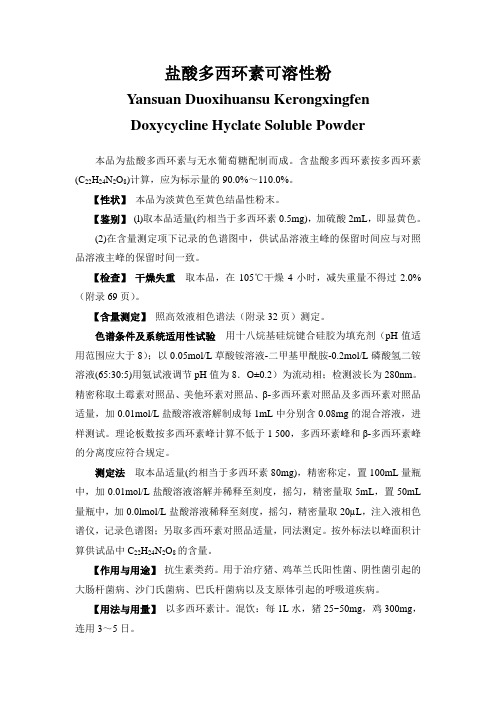
盐酸多西环素可溶性粉Yansuan Duoxihuansu KerongxingfenDoxycycline Hyclate Soluble Powder本品为盐酸多西环素与无水葡萄糖配制而成。
含盐酸多西环素按多西环素(C22H24N2O8)计算,应为标示量的90.0%~110.0%。
【性状】本品为淡黄色至黄色结晶性粉末。
【鉴别】(l)取本品适量(约相当于多西环素0.5mg),加硫酸2mL,即显黄色。
(2)在含量测定项下记录的色谱图中,供试品溶液主峰的保留时间应与对照品溶液主峰的保留时间一致。
【检查】干燥失重取本品,在105℃干燥4小时,减失重量不得过2.0%(附录69页)。
【含量测定】照高效液相色谱法(附录32页)测定。
色谱条件及系统适用性试验用十八烷基硅烷键合硅胶为填充剂(pH值适用范围应大于8);以0.05mol/L草酸铵溶液-二甲基甲酰胺-0.2mol/L磷酸氢二铵溶液(65:30:5)用氨试液调节pH值为8.O±0.2)为流动相;检测波长为280nm。
精密称取土霉素对照品、美他环素对照品、β-多西环素对照品及多西环素对照品适量,加0.01mol/L盐酸溶液溶解制成每1mL中分别含0.08mg的混合溶液,进样测试。
理论板数按多西环素峰计算不低于1 500,多西环素峰和β-多西环素峰的分离度应符合规定。
测定法取本品适量(约相当于多西环素80mg),精密称定,置100mL量瓶中,加0.01mol/L盐酸溶液溶解并稀释至刻度,摇匀,精密量取5mL,置50mL 量瓶中,加0.0lmol/L盐酸溶液稀释至刻度,摇匀,精密量取20µL,注入液相色谱仪,记录色谱图;另取多西环素对照品适量,同法测定。
按外标法以峰面积计算供试品中C22H24N2O8的含量。
【作用与用途】抗生素类药。
用于治疗猪、鸡革兰氏阳性菌、阴性菌引起的大肠杆菌病、沙门氏菌病、巴氏杆菌病以及支原体引起的呼吸道疾病。
【用法与用量】以多西环素计。
兽药盐酸多西环素质检报告及产品说明-链菌无踪

河南正大动物药业有限公司原料检验报告原料名称盐酸多西环素检验日期2011年05月08日规格100g/袋报告日期2011年05月09日检品来源仓库待验区检验项目全检批号20110505 数量50kg检验依据《中国兽药典》2005年版一部检验项目标准规定检验结果项目结论【性状】本品应为淡黄色的结晶性粉末本品为淡黄色的结晶性粉末符合规定无臭,味苦无臭,味苦比旋度应为-105°至-120°为-109°符合规定【鉴别】(1) 本品的红外吸收图谱应与对照本品的红外吸收图谱应与对照符合规定图谱一致图谱一致(2) 供试品溶液主峰的保留时间供试品溶液主峰的保留时间符合规定应与对照品的保留时间相同与对照品的保留时间相同(3) 本品的水溶液显氯化物的鉴别反应符合规定符合规定【检查】酸度PH值应为2.0~3.0 2.6 符合规定吸光度在349nm波长处测定应为测得的结果为0.30 符合规定0.28~0.31杂质吸光度在490nm波长处测定应测得的结果为0.08 符合规定不得过0.12有关物质应符合规定符合规定符合规定链菌无踪主治:畜禽细菌性疾病【主要成份】强力霉素【性状】本品为淡黄色或黄色粉末,味苦。
【适应症】主要用于变形大肠杆菌、沙门氏菌、霉形体等引起的病症。
对家禽细菌与霉形体混合感染,疗效更佳。
【主治】1、猪:传染性胸膜肺炎、喘气病、链球菌病、附红细胞体病等疗效极佳。
2、对鸡由禽流感等继发的慢性呼吸道病、弓形体、大肠杆菌、传染性鼻炎等呼吸道病有特效。
临床表现为拉稀、消瘦、无名高烧、耳炎、肛门周围发紫、血尿、呼吸困难、走路摇摆、突然死亡、转圈、关节肿大、皮肤化脓等症。
【用法用量】混饮:本品100g兑水300-400kg,每天2次,连用3-5天。
混饲:本品100g拌料200-250kg,每天2次,连用3-5天【规格】100g:强力霉素30g【包装】100g/袋检验结论:依据《中国兽药典》2005年版一部检验,结果符合规定。
盐酸多西环素可溶性粉(伴畜安)说明书
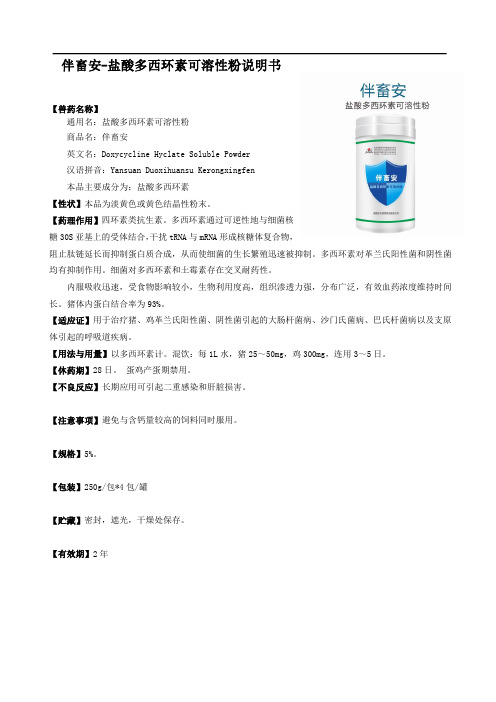
伴畜安-盐酸多西环素可溶性粉说明书
【兽药名称】
通用名:盐酸多西环素可溶性粉
商品名:伴畜安
英文名:Doxycycline Hyclate Soluble Powder
汉语拼音:Yansuan Duoxihuansu Kerongxingfen
本品主要成分为:盐酸多西环素
【性状】本品为淡黄色或黄色结晶性粉末。
【药理作用】四环素类抗生素。
多西环素通过可逆性地与细菌核
糖30S亚基上的受体结合,干扰tRNA与mRNA形成核糖体复合物,
阻止肽链延长而抑制蛋白质合成,从而使细菌的生长繁殖迅速被抑制。
多西环素对革兰氏阳性菌和阴性菌均有抑制作用。
细菌对多西环素和土霉素存在交叉耐药性。
内服吸收迅速,受食物影响较小,生物利用度高,组织渗透力强,分布广泛,有效血药浓度维持时间长。
猪体内蛋白结合率为93%。
【适应证】用于治疗猪、鸡革兰氏阳性菌、阴性菌引起的大肠杆菌病、沙门氏菌病、巴氏杆菌病以及支原体引起的呼吸道疾病。
【用法与用量】以多西环素计。
混饮:每1L水,猪25~50mg,鸡300mg,连用3~5日。
【休药期】28日。
蛋鸡产蛋期禁用。
【不良反应】长期应用可引起二重感染和肝脏损害。
【注意事项】避免与含钙量较高的饲料同时服用。
【规格】5%。
【包装】250g/包*4包/罐
【贮藏】密封,遮光,干燥处保存。
【有效期】2年。
盐酸多西环素可溶性粉说明书
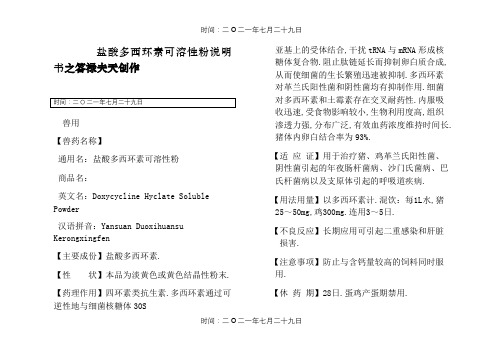
盐酸多西环素可溶性粉说明书之答禄夫天创作
兽用
【兽药名称】
通用名:盐酸多西环素可溶性粉
商品名:
英文名:Doxycycline Hyclate Soluble Powder
汉语拼音:Yansuan Duoxihuansu Kerongxingfen
【主要成份】盐酸多西环素.
【性状】本品为淡黄色或黄色结晶性粉末.
【药理作用】四环素类抗生素.多西环素通过可逆性地与细菌核糖体30S
亚基上的受体结合,干扰tRNA与mRNA形成核糖体复合物.阻止肽链延长而抑制卵白质合成,从而使细菌的生长繁殖迅速被抑制.多西环素对革兰氏阳性菌和阴性菌均有抑制作用.细菌对多西环素和土霉素存在交叉耐药性.内服吸收迅速,受食物影响较小,生物利用度高,组织渗透力强,分布广泛,有效血药浓度维持时间长.猪体内卵白结合率为93%.
【适应证】用于治疗猪、鸡革兰氏阳性菌、阴性菌引起的年夜肠杆菌病、沙门氏菌病、巴氏杆菌病以及支原体引起的呼吸道疾病.
【用法用量】以多西环素计.混饮:每1L水,猪25~50mg,鸡300mg.连用3~5日.
【不良反应】长期应用可引起二重感染和肝脏损害.
【注意事项】防止与含钙量较高的饲料同时服用.
【休药期】28日.蛋鸡产蛋期禁用.
时间:二O二一年七月二十九日
【规格】10%
【贮藏】遮光、密封,在干燥处保管.
时间:二O二一年七月二十九日。
盐酸多西环素可溶性粉说明书
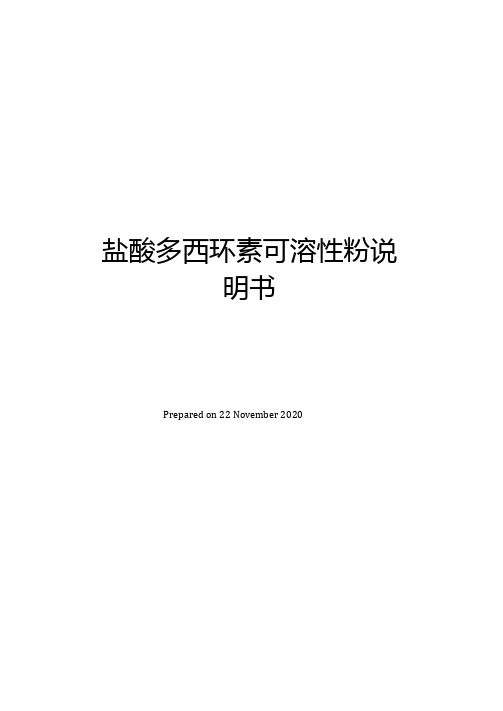
盐酸多西环素可溶性粉说
明书
Prepared on 22 November 2020
盐酸多西环素可溶性粉说明书
兽用
【兽药名称】
通用名:盐酸多西环素可溶性粉
商品名:
英文名:Doxycycline Hyclate Soluble Powder
汉语拼音:Yansuan Duoxihuansu Kerongxingfen
【主要成分】盐酸多西环素。
【性状】本品为淡黃色或黄色结晶性粉末。
【药理作用】四环素类抗生素。
多西环素通过可逆性地与细菌核糖体30S
亚基上的受体结合,干扰tR\A与mRNA形成核糖体复合物。
阻止肽链延长而抑制蛋口质合成,从而使细菌的生长繁殖迅速被抑制。
多西环素对革兰氏阳性菌和阴性菌均有抑制作用。
细菌对多西环素和土霉素存在交义耐药性。
内服吸收迅速,受食物影响较小,生物利用度高,组织渗透力强,分布广泛,有效血药浓度维持时间长。
猪体内蛋白结合率为93%。
【适应证】用于治疗猪、鸡革兰氏阳性菌、阴性菌引起的大肠杆菌病、沙门氏菌病、巴氏杆菌病以及支原体引起的呼吸道疾病。
【用法用量】以多西环素计。
混饮:每1L水,猪25〜50mg,鸡300mgo 连用3〜5日。
【不良反应】长期应用可引起二重感染和肝脏损害。
【注意事项】避免与含钙量较高的饲料同时服用。
【休药期】28日。
蛋鸡产蛋期禁用。
【规格】10%
【贮藏】遮光、密封,在干燥处保存。
- 1、下载文档前请自行甄别文档内容的完整性,平台不提供额外的编辑、内容补充、找答案等附加服务。
- 2、"仅部分预览"的文档,不可在线预览部分如存在完整性等问题,可反馈申请退款(可完整预览的文档不适用该条件!)。
- 3、如文档侵犯您的权益,请联系客服反馈,我们会尽快为您处理(人工客服工作时间:9:00-18:30)。
盐酸多西环素可溶性粉说明书兽用【兽药名称】通用名:盐酸多西环素可溶性粉商品名:英文名:doxycycline hyclate soluble powder 汉语拼音:yansuan duoxihuansu kerongxingfen 【主要成分】盐酸多西环素。
【性状】本品为淡黄色或黄色结晶性粉末。
【药理作用】四环素类抗生素。
多西环素通过可逆性地与细菌核糖体30s 亚基上的受体结合,干扰trna与mrna形成核糖体复合物。
阻止肽链延长而抑制蛋白质合成,从而使细菌的生长繁殖迅速被抑制。
多西环素对革兰氏阳性菌和阴性菌均有抑制作用。
细菌对多西环素和土霉素存在交叉耐药性。
内服吸收迅速,受食物影响较小,生物利用度高,组织渗透力强,分布广泛,有效血药浓度维持时间长。
猪体内蛋白结合率为93%。
【适应证】用于治疗猪、鸡革兰氏阳性菌、阴性菌引起的大肠杆菌病、沙门氏菌病、巴氏杆菌病以及支原体引起的呼吸道疾病。
【用法用量】以多西环素计。
混饮:每1l水,猪25~50mg,鸡300mg。
连用3~5日。
【不良反应】长期应用可引起二重感染和肝脏损害。
【注意事项】避免与含钙量较高的饲料同时服用。
【休药期】28日。
蛋鸡产蛋期禁用。
【规格】10% 【贮藏】遮光、密封,在干燥处保存。
篇二:注射用盐酸多西环素说明书注射用盐酸多西环素说明书【药品名称】通用名:注射用盐酸多西环素拼音名:zhusheyong yansuan duoxihuansu 英文名:doxycycline hydrochloride for injection 化学名:6-甲基-4-(二甲氨基)-3,5,10,12,12a,-五羟基-1,11-二氧代-1,4,4a,5,5a,6,11,12a-八氢-2-并四苯甲酰胺盐酸盐半乙醇半水合物分子式:c22h24n2o8﹒hcl﹒1/2 c2h5oh﹒1/2 h2o 分子量:512.93 【性状】本品为淡黄色或黄色结晶性粉末。
【药理毒理】多西环素为高效,广谱,长效抗生素,临床用途广泛,疗效确切,除对常见的革兰氏阳性球菌,阴性杆菌具有很好的抗菌作用外,还对衣原体,立克次体,支原体和附红细胞体病,弓形体病,焦虫病等原虫有抑制作用。
本品吸收快,分布广,作用强,维持时间长,能够快速杀灭病原体,排出毒素,清洁血液,控制感染。
【药代动力学】【适应症】1.附红细胞体病,弓形体病、焦虫病、链球菌病等引起的高热气喘、呼吸困难、皮肤发红变白或变蓝发紫,耳廓边缘、尾尖及四肢末梢发绀,毛囊有出血点,眼红流泪,便秘、黄疸、尿色赤黄、血液稀薄、站立不稳、跛脚、剧烈腹泻、食欲下降、精神萎顿等症状。
2.支原体,肺炎球菌等敏感菌所致的喘气病、传染性胸膜肺炎、各种畜禽的肺炎和支气管肺炎等呼吸系统疾病。
3.金黄色葡萄球菌、链球菌、肺炎球菌、溶血性链球菌、支原体、副嗜血杆菌、猪痢疾密螺旋体、消化球菌、淋球菌、脑膜炎杆菌、流感杆菌、大肠杆菌、沙门氏菌、绿脓杆菌、双球菌、志贺氏菌、巴氏杆菌、布氏杆菌等敏感菌感染以及混合感染、继发感染。
4.本品对仔猪黄白痢、仔猪水肿病、仔猪副伤寒也具有良好的效果。
【用法和用量】将本品加入适量注射用水稀释,溶解后肌内注射一次量每1kg体重马,牛3-5mg(相当于每200kg用本品一支),羊、猪5-10mg(相当于每100kg用本品一支),犬、猫10-15mg,禽15—25mg一般病症一日1次,连用2-3日重症一日2次注射时也可用5%葡萄糖注射液制成0.1%以下浓度,缓缓注入,不可漏于皮下。
【不良反应】暂未发现。
【禁忌】【注意事项】本品久置后有结块或粘瓶现象,稀释溶解后使用不影响疗效。
【孕妇及哺乳期妇女用药】【儿童用药】【老年患者用药】【药物相互作用】【药物过量】【规格】100mg 【贮藏】遮光,密闭保存。
【有效期】18个月篇三:盐酸多西环素胶囊说明书盐酸多西环素胶囊说明书【药品名称】通用名:盐酸多西环素胶囊英文名:doxycycline hyclate capsules 汉语拼音:yansuan duoxihuansu jiaonang 【成分】本品主要成份为:盐酸多西环素。
化学名称:6-甲基-4-(二甲氨基)-3,5,10,12,12a,-五羟基-1,11-二氧代-1,4,4a,5,5a,6,11,12a-八氢-2-并四苯甲酰胺盐酸盐半乙醇半水合物。
化学结构式:分子式:c22h24n2o8·hcl·1/2c2h5oh,1/2h2o 分子量:512.93【性状】本品为胶囊剂,内容物为淡黄色至黄色的微丸。
【适应症】1.本品作为选用药物之一可用于下列疾病:(1)立克次体病,如流行性斑疹伤寒、地方性斑疹伤寒、洛矶山热、恙虫病和q热(2)支原体属感染(3)衣原体属感染,包括鹦鹉热、性病、淋巴肉牙肿、非特异性尿道炎、输卵管炎、宫颈炎及沙眼(4)回归热(5)布鲁菌病(6)霍乱(7)兔热病(8)鼠疫(9)软下疳治疗布鲁菌病和鼠疫时需与氨基糖苷类联合应用。
2.由于目前常见致病菌对四环素类耐药现象严重,仅在病原菌对本品敏感时,方有应用指征。
葡萄球菌属大多对本品耐药。
3.本品可用于对青霉素类过敏患者的破伤风、气性坏疽、雅司、梅毒、淋病和钩端螺旋体病以及放线菌属、李斯特菌感染。
4.可用于中、重度痤疮患者作为辅助治疗。
【规格】0.1g(按c22h24n2o8计算)【用法用量】口服。
抗菌及抗寄生虫感染:成人,第一日100mg,每12小时1次,继以100~200mg,一日1次,或50~100mg,每12小时1次。
淋病奈瑟菌性尿道炎和宫颈炎:一次100mg,每12小时1次。
共7日。
非淋病奈瑟菌性尿道炎,由沙眼衣原体或解脲脲原体引起者,以及沙眼衣原体所致的单纯性尿道炎、宫颈炎或直肠感染:均为一次100mg,一日2次,疗程至少7日。
梅毒:一次150mg,每12小时1次,疗程至少10日。
8岁以上小儿第一日按体重2.2mg/kg,每12小时1次,继以按体重2.2~4.4mg/kg,一日1次,或按体重2.2mg/kg,每12小时1次。
体重超过45kg的小儿用量同成人。
【不良反应】1.消化系统:本品口服可引起恶心、呕吐、腹痛、腹泻等胃肠道反应。
偶有食管炎和食管溃疡的报道,多发生于服药后立即卧床的患者。
2.肝毒性:脂肪肝变性患者和妊娠期妇女容易发生,亦可发生于并无上述情况的患者。
偶可发生胰腺炎,本品所致胰腺炎也可与肝毒性同时发生,患者并不伴有原发肝病。
3.过敏反应:多为斑丘疹和红斑,少数病人可有荨麻疹、血管神经性水肿、过敏性紫癜、心包炎以及系统性红斑狼疮皮损加重,表皮剥脱性皮炎并不常见。
偶有过敏性休克和哮喘发生。
某些用本品的患者日晒可有光敏现象。
所以,建议患者服用本品期间不要直接暴露于阳光或紫外线下,一旦皮肤有红斑应立即停药。
4.血液系统:偶可引起溶血性贫血、血小板减少、中性粒细胞减少和嗜酸粒细胞减少。
5.中枢神经系统:偶可致良性颅内压增高,可表现为头痛、呕吐、视神经乳头水肿等,停药后可缓解。
6.二重感染:长期应用本品可发生耐药金黄色葡萄球菌、革兰阴性菌和真菌等引起的消化道、呼吸道和尿路感染,严重者可致败血症。
7.四环素类的应用可使人体内正常菌群减少,并致维生素缺乏、真菌繁殖,出现口干、咽炎、口角炎和舌炎等。
【禁忌】有四环素类药物过敏史者禁用。
【注意事项】1.应用本品时可能发生耐药菌的过度繁殖。
一旦发生二重感染,即停用本品并予以相应治疗。
2.治疗性病时,如怀疑同时合并梅毒螺旋体感染,用药前须行暗视野显微镜检查及血清学检查,后者每月1次,至少4次。
3.长期用药时应定期随访检查血常规以及肝功能。
4.肾功能减退患者可应用本品,不必调整剂量,应用本品时通常亦不引起血尿素氮的升高。
5.本品可与食品、牛奶或含碳酸盐饮料同服。
【孕妇及哺乳期妇女用药】本品可透过胎盘屏障进入胎儿体内,沉积在牙齿和骨的钙质区内,引起胎儿牙齿变色、牙釉质再生不良及抑制胎儿骨骼生长,该类药物在动物实验中有致畸胎作用,因此孕妇不宜应用。
本品可自乳汁分泌,乳汁中浓度较高,哺乳期妇女应用时应暂停哺乳。
【儿童用药】8岁以下儿童禁用。
【老年患者用药】尚不明确。
【药物相互作用】1.本品可抑制血浆凝血酶原的活性,所以接受抗凝治疗的患者需要调整抗凝药的剂量。
2.巴比妥类、苯妥英或卡马西平与本品同用时,上述药物可由于诱导微粒体酶的活性致多西环素血药浓度降低,因此须调整多西环素的剂量。
【药物过量】本品无特异性拮抗药,药物过量时应给予催吐、洗胃及大量饮水及补液等对症治疗及支持治疗。
【药理毒理】四环素类抗生素。
本品为广谱抑菌剂,高浓度时具杀菌作用。
许多立克次体属、支原体属、衣原体属、非典型分枝杆菌属、螺旋体也对本品敏感。
本品对革兰阳性菌作用优于革兰阴性菌,但肠球菌属对其耐药。
其他如放线菌属、炭疽杆菌、单核细胞增多性李斯特菌、梭状芽孢杆菌、奴卡菌属、弧菌、布鲁菌属、弯曲杆菌、耶尔森菌对本品敏感。
本品对淋病奈瑟菌具一定抗菌活性,但耐青霉素的淋病奈瑟菌对多西环素也耐药。
多年来由于四环素类的广泛应用,临床常见病原菌对本品耐药现象严重,包括葡萄球菌等革兰阳性菌及多数革兰阴性杆菌。
本品与四环素类抗生素不同品种之间存在交叉耐药。
本品作用机制为药物能特异性与细菌核糖体30s亚基的a位置结合,抑制肽链的增长和影响细菌蛋白质的合成。
动物试验证实本品有致畸性。
体外试验表明本品在一定浓度时有致突变的可能。
【药代动力学】本品口服吸收完全,约可吸收给药量的90%以上,进食对本品吸收的影响小。
单剂口服本品100mg后,血药高峰浓度为1.8~2.9mg/l。
吸收后广泛分布于体内组织和体液,多西环素有较高的脂溶性,对组织穿透力较强,在胸导管淋巴液、腹水、肠组织、眼和前列腺组织中均有较高浓度,约为血药浓度的60%~75%,在胆汁中浓度可达同期血药浓度的10~20倍,表观分布容积(vd)为0.7l/kg。
蛋白结合率为80%~93%,血消除半衰期(t1/2)为12~22小时,肾功能减退者t1/2?延长不明显。
本品部分在肝内代谢灭活,主要自肾小球滤过排泄,给药后24小时内可排出约35%~40%。
肾功能损害患者应用本品时,药物自胃肠道的排泄量增加,成为主要排泄篇四:doxycycline多西环素台湾 ,用药 ,说明doxycycline 多西环素(去氧羥四環素)<<商品名>>台灣健保藥品 - duramycin 久力黴素膠囊, remycin 利敏黴素膠囊, doxymycin 多喜黴素腸溶膠囊, doxymycin 多喜黴素腸溶錠, doxymycin 多喜黴素膠囊, dx 多賜膠囊, doryx妥立克膠囊, doxynin 得喜寧膠囊, doxycycline 得基黴素膠囊, doxycycline 德士黴素膠囊, doxycycline 德霸黴素膠囊, doxycycline 永樂喜膠囊, venmoimycin 泛美黴素膠囊,withamycin溫達黴素膠囊, weibamycin 為他黴素膠囊, doinmycin 特林黴素膠囊,doxycycline 獨克士黴素膠囊, bistor 獨拉膠囊, doxcycline 的士黴素膠囊, doxyclin 道西林腸溶膠囊.美國- adoxa; adoxa pak 1/150; alodox; doryx; vibramycin 加拿大 - apo-doxytabs; apo-doxy; dom-doxycycline; doxycin; doxytab; novo-doxylin; nu-doxycycline; periostat; phl-doxycycline; pms-doxycycline; vibra-tabs; vibramycin amermycin (香港,泰國); doryx (澳大利亞 , 紐西蘭); doxy-100 (德國 , 紐西蘭);doxycap (新加坡); doxycline (盧森堡,泰國); doxyhexal (澳大利亞 , 盧森堡); doxylin(澳大利亞 , 以色列,挪威, 紐西蘭, 泰國); doxyline (新加坡); granudoxy (法國, 盧森堡); medomycin (馬來西亞, 新加坡, 泰國); supracyclin (奧地利,瑞士); unidox (阿拉伯,波蘭); vibradox (丹麥, 葡萄牙); vibramicina (阿根廷, 墨西哥, 葡萄牙, 烏拉圭);vibramycin (阿拉伯, 奧地利,澳大利亞, 瑞士, 德國, 希臘, 香港,印尼, 愛爾蘭, 馬來西亞, 荷蘭,挪威)菲律賓, 巴基斯坦,俄羅斯, 瑞典, 泰國, 南非) <<藥物作用>>本藥為一種「四環素類」的抗生素。
